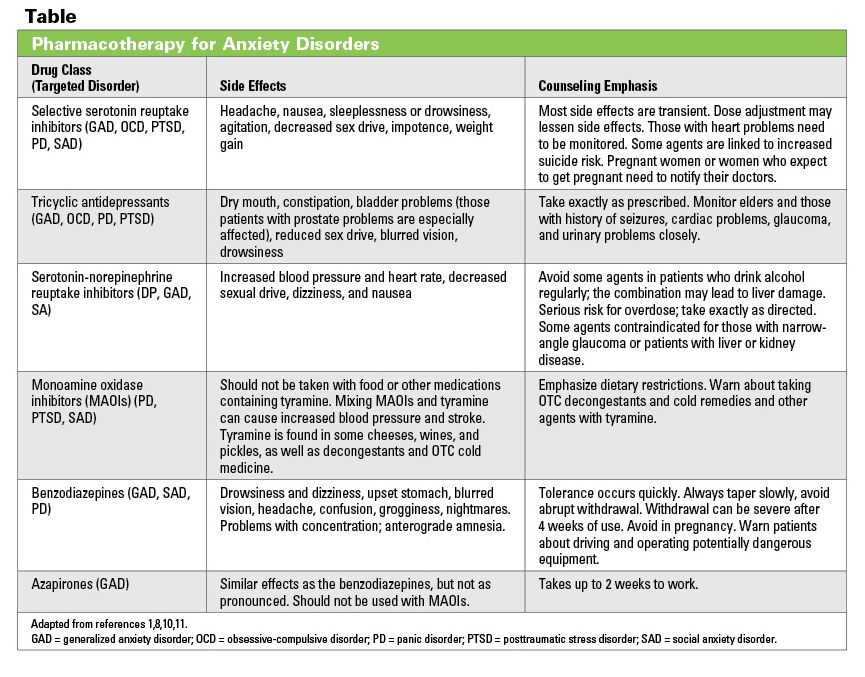Publication
Article
Pharmacy Times
Managing Anxiety Disorders
Author(s):
Anxiety disorders affect 40 million American adults annually, often co-occurring with other medical and psychiatric disorders. The most common disorders are described here.
Dr. Zanni is a psychologist and a health systems consultant based in Alexandria, Virginia.
Anxiety disorders affect 40 million American adults (18.1% of the population) annually, often co-occurring with other medical and psychiatric disorders.1 Ten categories comprise anxiety disorders; the 6 most common are described in the Table. Prevalence is highest for specific phobias, social anxiety, and posttraumatic stress, affecting 8.7%, 6.8%, and 3.5% of Americans, respectively.2-4 More women than men suffer from generalized anxiety disorder, panic disorder, and specific phobias.4
These disorders share 3 defining characteristics: distorted cognitive processes (irrational thoughts), excessive reactions including excessive physiological arousal, and a feeling of dread.1 Anxiety disorders differ from normal situational anxiety by their longer duration and physical and psychological impairment. Patients with anxiety disorders have higher rates of mortality from all causes.1,5

Assessment
Because anxiety mimics many symptoms associated with numerous illnesses, patients frequently present with physical complaints. Although practitioners have little difficulty in recognizing anxiety, the challenge is to determine if anxiety is the primary problem or the manifestation of another pathology. Anxiety and paniclike symptoms co-occur with several pathologies, including asthma, angina, cardiac arrhythmias, hyperthyroidism, hyperparathyroidism, vestibular dysfunction, transient ischemic attacks, and seizure disorders.
Practitioners must determine if anxiety is a symptom of other psychiatric disorders, including psychosis or substance abuse withdrawal.6 They should consider the possibility of medicationinduced anxiety. Several agents can produce anxiety-like symptoms (eg, epinephrine or other sympathomimetics, theophylline or other neurostimulant bronchodilators, analgesics, steroids, some selective serotonin reuptake inhibitors [SSRIs], digoxin, corticosteroids, antivirals).1,7
Treatment
Experts recommend pharmacotherapy combined with cognitive-behavioral therapy (CBT), as the combination is superior to either alone.2 Many agents treat anxiety effectively, but relapse is common: 25% relapse within 1 month of discontinuing medication; 60% to 80% relapse within 1 year.1 SSRIs or the serotonin-norepinephrine reuptake inhibitors are drugs of choice for anxiety disorders.8 Benzodiazepines are mostly used for patients unresponsive to first-line agents. Beta-blockers, alpha- blockers, anticonvulsants, and atypical antipsychotics are used adjunctively, targeting physiologic and cognitive symptoms. Beta-blockers, for example, decrease rapid heart rate, and are especially useful for phobias or panic attacks.2 In treating elders, geriatricians recommend “Start low, go slow.”
Cognitive-Behavioral Therapy
The goal of CBT is twofold: changing thinking patterns and irrational fears as they relate to the individual’s anxiety, and changing reactions to anxiety-provoking stimuli. For example, CBT will first help patients with panic disorders learn that they are not having a heart attack, and then change their behavioral reaction to the stimuli. CBT usually incorporates relaxation techniques.
CBT is short-term, usually lasting about 12 weeks. It may be conducted individually or in group therapy. Group therapy is particularly effective for social phobia. Therapists often assign “homework” for participants between sessions. 2
Counseling
Counseling begins by rejecting our stigmatizing cultural attitude that anxiety is a character flaw and that the individual should “just deal with it.” Individuals with anxiety are seriously impaired. In most instances, the patient is controlled by anxiety and unable to cope. Pharmacists filling prescriptions for antianxiety agents should offer encouragement, emphasizing that treatment works. Remind patients that it may take 2 or 3 weeks before they notice improvement, and encourage adherence. Inform patients of side effects that are temporary or enduring. If a patient cannot tolerate side effects, encourage them to call their provider to consider an alternative drug. Be especially encouraging to patients who may have already failed on one treatment agent.
Warn patients not to discontinue medication abruptly and that symptoms may reappear if they stop medication. If patients state they were in psychotherapy and had little success, probe to determine if it was CBT. If not, encourage patients to give it another try. If the patient is being tapered off benzodiazepines, explain that it is normal to feel withdrawal symptoms, including anxiety, but that these feelings are transient. Advise avoiding caffeine and other stimulants.
Patients considering herbal supplements should consult with their doctor. Although valerian and kava are sedating, both have potential troubling side effects.1
If a patient has a panic attack in your presence, stay calm. Reassure the patient that you will not leave him/her alone. If the individual has a history of attacks, gently tell the patient that the attack will end soon. If the patient is hyperventilating, encourage slower respirations. If the patient reaches out to you, hold the individual’s hand; otherwise, keep your distance.9 Refer patients to organizations that offer consumer information and support for those with anxiety disorders, such as the Anxiety Disorders Association of America (www.adaa.org).
Final Thought
Most people experience anxiety at some point in their lives. When anxiety becomes chronic and impairing, it ceases being normal. Some may even be too anxious to see a provider. Encouragement and hand-holding may be the first intervention. â–
References
1. Gliatto MF. Generalized anxiety disorder. Am Fam Physician. 20001;62:1591-600, 1602.
2. National Institute of Mental Health. Anxiety disorders. Available at http://www.nimh.nih.gov/health/publications/anxiety-disorders/complete-index.shtml. Accessed November 28, 2009.
3. National Mental Health Information Center. Anxiety disorders. Available at http://mentalhealth.samhsa.gov/publications/allpubs/ken98-0045/default.asp. Accessed November 27, 2009.
4. Anxiety Disorders Association of America. Statistics and facts about anxiety disorders. Available at http://www.adaa.org/AboutADAA/PressRoom/Stats&Facts.asp Accessed November 29, 2009.
5. Baldwin DS. Evidence-based guidelines for anxiety disorders: can they improve
clinical outcomes? CNS Spectr. 2006;11(10 Suppl 12):34-9.
6. Starcevic V. Anxiety states: a review of conceptual and treatment issues. Curr
Opin Psychiatry
. 2006;19:79-83.
7. Yates W. Anxiety disorders. Available at http://emedicine.medscape.com/article/286227-diagnosis. Accessed December 5, 2009.
8. University of Maryland Medical Center. Anxiety disorders—medications. Available at http://www.umm.edu/patiented/articles/what_medications_used_anxiety_disorders_000028_7.htm. Accessed December 5, 2009.
9. Drew B. What should I do if a client has a panic attack during an office visit? http://www.medscape.com/viewarticle/710351. Accessed November 27, 2009.
10. Anxiety Disorders Association of America. Medications for anxiety disorders. Available at http://www.adaa.org/gettinghelp/AnxietyDisorders/Medications.asp. Accessed November 28, 2009.
11. National Institute of Mental Health. Mental Health Medications. Available at http://www.nimh.nih.gov/health/publications/mental-health-medications/complete-index.shtml. Accessed December 8, 2009.







